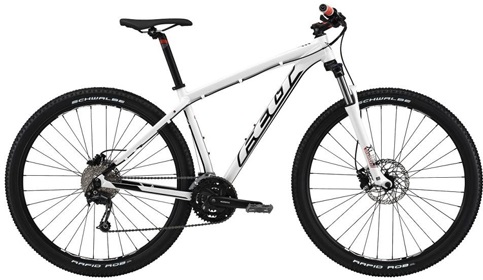

How to Choose a Mountain Bike
Mountain bikes were designed for rougher terrain, but they can cope equally well with normal paved roads. Their versatility has made them very popular.

Frequently asked questions when choosing a bike
Is a mountain bike suitable for everyday use?
Yes, mountain bikes are suitable for virtually any type of bike riding. They are comfortable and allow you to go on a longer trip, commute to work, ride down the city streets, or venture into the countryside.
Can I improve its road properties?
Yes. If you want a mountain bike but expect to ride on paved roads often, you can replace its tires for smoother road bike ones.
Do I need a bike with a suspension system?
Bicycle suspension insulates the rider from the roughness of the terrain, making your riding more comfortable. Some suspension systems don't have a lockout feature, however. When riding uphill, the system will transfer the force from the pedals to the fork, absorbing some of your energy in the process.
How do I sit on a mountain bike?
Mountain bikes seat you in the so-called neutral sitting position, with your body posed at a 40° angle. It doesn’t strain your back, but it’s also not as leisurely as an upright position.
Important Parameters


Frame height
Frame height is usually measured in inches or sizes S, M, L, XL and is determined by the distance from your foot to crotch or by your total height.
Body height in cm | Frame height according to size | |
|---|---|---|
| less than 165 cm | 15", 16", S, up to 44 cm | |
| 160-170 cm | 17", 18", M, up to 48 cm | |
| 170-185 cm | 19", 20", L, up to 52 cm | |
| 185-200 cm | 21", 22", L, up to 55 cm | |
| over 195 cm | 23", 24" L, 58-60 cm | |
*The chart is only for the general reference, as in rare cases, the details may vary. | ||

Frame material
Steel frames are tough and cheaper than other options. The downside is their higher weight and tendency to rust. Carbon frames are lighter, flexible, and don't weaken over time. Duralumin frames are cheaper, but heavier than carbon frames.

Suspension
Full suspension is suitable for the harshest and most demanding terrain. Front suspension bikes are mainly designed for city or bike path riding, but can also cope with trips to the countryside. Also make sure the bike has both a front and rear suspension lockout feature, to prevent it from absorbing the power you apply when riding uphill.

Brakes
The most common are the so-called v-brakes, which brake by rubbing the friction pads against the rim. They are cheap, easy to maintain, but their braking effect drops when the mechanism gets wet. The second option are the disc brakes, which work equally well when wet or dry. On the downside, their maintenance is more difficult. Disc brakes are controlled by cable or hydraulically.
Glossary - Bikes
Gears
Featured on most bikes, gears allow you to select the degree of difficulty when pedaling. At low gears (e.g. when cycling uphill), pedalling is easier, but the pedal frequency increases at the same time. Conversely, when using a high gear (e.g. on a flat road), you pedal less but more forcefully. Gears are essential for anyone who plans to cycle on mixed or hilly terrain.
Frame
An ideal bike frame is lightweight and sturdy. Frame sizes are measured in inches or units, or sizes S, M, L, XL. Bicycle frames are typically made from steel, aluminium or carbon fibre. Steel frames were once common but are now in decline; while being strong and relatively cheap, they are heavier and subject to rust. Alloy frames are cheaper but heavier than carbon fibre frames, which offer a lighter, more flexible, and yet equally strong option.
Fork
The front fork is a key component of any bicycle and determines its overall quality. Suspension forks use compressed air or a spring system to insulate the rider from the roughness of the terrain. Air suspension is the more common option, despite it being more expensive than spring suspension; moreover, the air pressure can be adjusted to the weight of the rider. Spring suspension is the cheaper option and provides a slightly more sensitive damping; however, one disadvantage is that the spring force depends on the weight of the rider, and sometimes the spring can harden at low temperatures.
Glossary

Wheel diameter
26" wheels are the smallest size available on normal adult bikes. The lower height gives you a sense of safety and control and makes the bike easier to handle. Suitable for difficult, uneven terrain full of sharp turns.
27.5" is the universal medium size, which offers a combination of decent speed and good handling.
29" wheels are the fastest, but handling a bike this large requires quite a lot of physical strength. The ideal stature for 29" bikes is 175-180 cm and more. Large wheels cope better with bumps on the road and have better traction, so they are used by most athletes.
For more information on how to choose the right bike size, read our article.